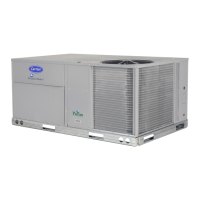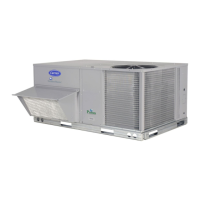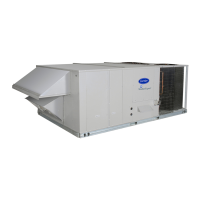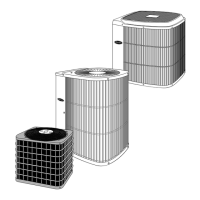during unit operation. Termination occurs when coil thermistor
reaches 80°F (±5°) or defrost period reaches a maximum of 10
minutes. Defrost will occur at the compressor capacity that is being
called for. During defrost, unit operates in high or low capacity,
energizes reversing valve O and auxiliary heat W2, and de-
energizes outdoor fan. Upon termination, there is a 20-sec delay in
outdoor fan being energized.
FIELD-INITIATED FORCED DEFROST
By placing a jumper across forced defrost terminals (See Fig. 14)
for a minimum of 5 sec and then removing it, a defrost cycle can
be initiated. The cycle occurs only if outdoor ambient is less than
50°F, regardless of outdoor coil temperature. The cycle terminates
when coil thermistor reaches 80°F (±5°) or defrost period reaches
a maximum of 10 minutes.
COMPRESSOR VOLTAGE FAILURE (6 FLASHES)
The control senses the voltage of the compressor run winding. If
compressor voltage (Vc) is less than 90v when control board is
calling for compressor operation, control de-energizes compressor
contactor for 15 minutes with outdoor fan running. After 15
minutes (provided there is a call for Y1 or Y2), control attempts to
start compressor. During this time, a code of 6 flashes appears at
control board. If Vc trip occurs 3 consecutive times during a Y1
request, then low capacity operation is locked out and control
responds to Y2 requests until a reset occurs. If 3 consecutive trips
occur in a combination of Yl and Y2 or all Y2 requests, then both
low and high capacity operation will be locked out. The compres-
sor voltage failure (6 flashes) can be caused by:
• compressor internal overload trip (refer to Table 7 for correct
winding resistance)
• no 208/230 volt power supply to outdoor unit
• failed compressor contactor(s)
• failure of start relay to pick-up properly
• improper wiring
PRESSURE SWITCH PROTECTION
The outdoor unit is equipped with high- and low-pressure
switches. If the control senses the opening of the high or low
pressure switch, it will respond as follows:
1. De-energize the compressor hi or low speed contactor.
2. Keep the outdoor fan operating for 15 minutes.
3. Display the appropriate error code on the status light (see
Table 4).
4. After a 15 minute delay, if Yl or Y2 inputs are on and the LPS
or HPS is reset, energize appropriate compressor contactor,
either low or high.
5. If LPS or HPS has not closed after 15 minute delay, outdoor
fan is turned off. If the open switch closes anytime after the
15-minute delay, then resume operation on call for Y1 and/or
Y2.
HEATING VAPOR PRESSURE SWITCH
(PressureGuard™)
This outdoor unit is equipped with a heating vapor pressure
limiting device which cycles the outdoor fan at high ambient
heating conditions. The exact ambient at which outdoor fan cycles
depends on indoor and outdoor unit sizing. The effect of outdoor
fan cycling on HSPF (Heating Seasonal Performance Factor) is
insignificant, due to its occurrence at outdoor ambient where
building load is very low. Puron® is a high-pressure refrigerant.
The purpose of this switch is to provide maximum flexibility and
minimum cost for the installer/owner by not requiring special
thicker wall vapor tubing and indoor coils, thus allowing limited
retrofit. The use of this switch also allows the maximum number
of indoor coil choices at minimum cost for the installer/owner,
since it can use standard refrigerant tubing.
NOTE: Due to the presence of a vapor pressure switch in outdoor
unit fan circuit and the possibility of fan cycling, this unit may go
into brief defrost at high ambient heating conditions.
MAJOR COMPONENTS
Two-Speed Control
The two-speed control board controls the following functions:
• Low- and high-compressor contactor operation
• Outdoor fan motor operation
• Crankcase heater operation
• Compressor protection
• Pressure switch monitoring
• Time delays
• Time/temperature defrost
• Defrost interval selection
• Electric heat operation during defrost mode
Field Connections
The two-speed control received 24vac low-voltage control system
inputs through the screw connections on the left side of the control
board.
Dual Capacity Compressor
The dual capacity compressor contains motor windings that
provide 3500 RPM operation. Refer to Table 7 for correct winding
resistance.
Table 4—LED Control Function Light Code
CODE DEFINITION *
Constant flash
No pause
No demand
Stand by
10
1 flash
w/pause
Low-speed operation 9
2 flashes
w/pause
High-speed operation 8
3 flashes
w/pause
Outdoor ambient thermistor failure 7
4 flashes
w/pause
Outdoor coil thermistor failure 6
3 flashes
pause
4 flashes
Thermistor out of range† 5
5 flashes
pause
1 flash
Low pressure switch trip 4
5 flashes
w/pause
2 flashes
High pressure switch trip 3
6 flashes
w/pause
Compressor V
C
/V
H
trip 2
Constant light
No pause
No flash
Board failure 1
*Function light signal order of importance in case of multiple signal request; 1
is most important.
†Check both thermistors to determine which is faulty.
Table 5—Defrost Dip Switch Settings
TIME DIP SWITCH #1 DIP SWITCH #2
30 up down
60 down up
90 down down
120 up up
12

